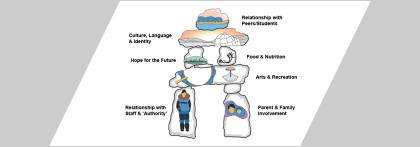Elections Canada supports the learning of Indigenous students across the north through its partnership with Connected North.
Connected North provides live, interactive virtual learning experiences and access to educational resources for students and teachers in remote communities.
Since 2019, our Civic Education team has virtually visited over 30 schools while interacting with students from Haida Gwaii, British Columbia, to Pond Inlet, Nunavut, and many communities in between. We deliver learning sessions about elections and democracy to support northern communities, where being far from services often creates a barrier.
Connected North has developed a well-being framework in collaboration with communities, elders and knowledge-keepers. This framework has helped us to assess how well our programs are supporting Indigenous students and their educators in northern and remote communities.
The framework includes seven factors that can influence well-being:
- Relationship with Peers/Students
- Culture, Language and Identity
- Hope for the Future
- Food & Nutrition
- Arts & Recreation
- Relationship with Staff & “Authority”
- Parent & Family Involvement
As shown in the image above, the well-being framework is represented as an inukshuk that is made up of these seven factors. To learn more about each one, visit Connected North’s web content on well-being in schools.
By developing positive “Relationships with Peers/Students” and “Inspiring Hope for the Future,” our educational resources support two factors in the well-being framework.
Relationships with peers/students are developed through positive interactions over time. Our resources encourage and facilitate group work, discussion and engagement with hands-on materials and thought-provoking inquiry questions. They also include language learner materials so that all students can participate in the discussion. For example, in Voting Rights through Time, students spend most the activity in small group conversations, placing their case study cards on their timeline activity mat and discussing their choices before sharing with the class. Hope for the future is supported by “programming that has students identify, investigate and act on issues in and around their community.” This is one of the main goals in Civic Action: Then and Now. Students first analyze case studies of successful past civic actions through a hands-on card-based activity. They can then use the framework to start planning their own civic actions on issues that they care about in their own communities.
The Election Simulation Toolkit is another resource through which students identify an issue in their school or community. They run a mini-campaign, manage an in-class polling station and “elect” a candidate who represents their views. The resource includes a speech scaffold to help all students succeed and empowers students to speak up on issues that they care about.
Another way to build hope for the future is by making connections to the workforce and potential employers. By participating in a simulated election in their own classroom, students can find out for themselves what it is like to participate in an election as a voter, as an election worker, and as a candidate, or by supporting a campaign.
We look forward to continuing to build our relationships with students, educators and schools in remote Indigenous communities through Connected North. The well-being framework will be a valuable tool to help us continue to improve our programs and services in the years to come.


